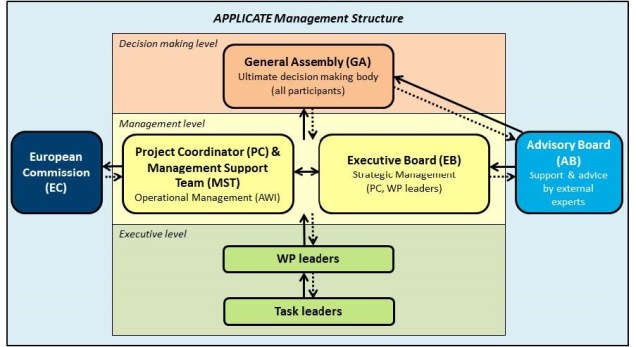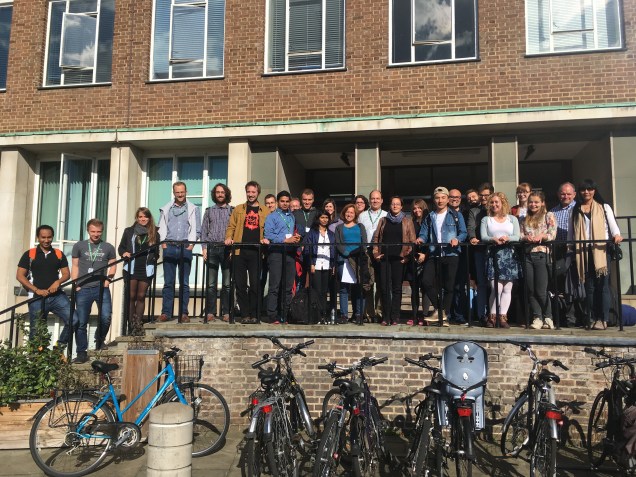Email: sally.woodhouse@pgr.reading.ac.uk
The Arctic region is rapidly changing, with surface temperatures warming at around twice the global average and sea ice extent is rapidly declining, particularly in the summer. These changes affect the local ecosystems and people as well as the rest of the global climate. The decline in sea ice has corresponded with cold winters over the Northern Hemisphere mid-latitudes and an increase in other extreme weather events (Cohen et al., 2014). There are many suggested mechanisms linking changes in the sea ice to changes in the stratospheric jet, midlatitude jet and storm tracks; however this is an area of active research, with much ongoing debate.

It is therefore important that we are able to understand and predict the changes in the Arctic, however there is still a lot of uncertainty. Stroeve et al. (2012) calculated time series of September sea ice extent for different CMIP5 models, shown in Figure 1. In general the models do a reasonable job of reproducing the recent trends in sea ice decline, although there is a large inter-model spread and and even larger spread in future projections. One area of model development is increasing the horizontal resolution – where the size of the grid cells used to calculate the model equations is reduced.
The aim of my PhD is to investigate the impact that climate model resolution has on the representation of the Arctic climate. This will help us understand the benefits that we can get from increasing model resolution. The first part of the project was investigating the impact of atmospheric resolution. We looked at three experiments (using HadGEM3-GC2), each at a different atmospheric resolutions: 135km (N512), 60km (N216) and 25km (N96).

The annual mean sea ice concentration for observations and the biases of the 3 experiments are shown in Figure 2. The low resolution experiment does a good job of producing the sea extent seen in observations with only small biases in the marginal sea ice regions. However, in the higher resolution experiments we find that the sea ice concentration is much lower than the observations, particularly in the Barents Sea (north of Norway). These changes in sea ice are consistent with warmer temperatures in the high resolution experiments compared to the low resolution.
To understand where these changes have come from we looked at the energy transported into the ocean by the atmosphere and the ocean. We found that there is an increase in the total energy being transported into the Arctic which is consistent with the reduced sea ice and warmer temperatures. Interestingly, the increase in energy is being transported into the Arctic by the ocean (Figure 3), even though it is the atmospheric resolution that is changing between the experiments. In the high resolution experiments the ocean energy transport into the Arctic, 0.15 petawatts (PW), is in better agreement with observational estimates, 0.154 PW, from Tsubouchi et al. (2018). Interestingly, this is in contrast to the worse representation of sea ice concentration in the high resolution experiments. (It is important to note that the model was tuned at the low resolution and as little as possible was changed when running the high resolution experiments which may contribute to the better sea ice concentration in the low resolution experiment.)


We find that the ocean is very sensitive to the differences in the surface winds between the high and low resolution experiments. In different regions the differences in winds arise from different processes. In the Davis Strait the effect of coastal tiling is important, where at higher resolution a smaller area is covered by atmospheric grid cells that cover both land and ocean. In a cell covering both land and ocean the model usually produces wind speeds to low for over the ocean. Therefore in the higher resolution experiment we find that there are higher wind speeds over the ocean near the coast. Whereas over the Fram Strait and the Barents Sea instead we find that there are large scale atmospheric circulation changes that give the differences in surface winds between the experiments.
References
Cohen, J., Screen, J. A., Furtado, J. C., Barlow, M., Whittleston, D., Coumou, D., Francis, J., Dethloff, K., Entekhabi, D., Overland, J. & Jones, J. 2014: Recent Arctic amplification and extreme mid-latitude weather. Nature Geoscience, 7(9), 627–637, http://dx.doi.org/10.1038/ngeo2234
Stroeve, J. C., Kattsov, V., Barrett, A., Serreze, M., Pavlova, T., Holland, M., & Meier, W. N., 2012: Trends in Arctic sea ice extent from CMIP5, CMIP3 and observations. Geophysical Research Letters, 39(16), 1–7, https://doi.org/10.1029/2012GL052676
Tsubouchi, T., Bacon, S., Naveira Garabato, A. C., Aksenov, Y., Laxon, S. W., Fahrbach, E., Beszczynska-Möller, A., Hansen, E., Lee, C.M., Ingvaldsen, R. B. 2018: The Arctic Ocean Seasonal Cycles of Heat and Freshwater Fluxes: Observation-Based Inverse Estimates. Journal of Physical Oceanography, 48(9), 2029–2055, http://journals.ametsoc.org/doi/10.1175/JPO-D-17-0239.1

































